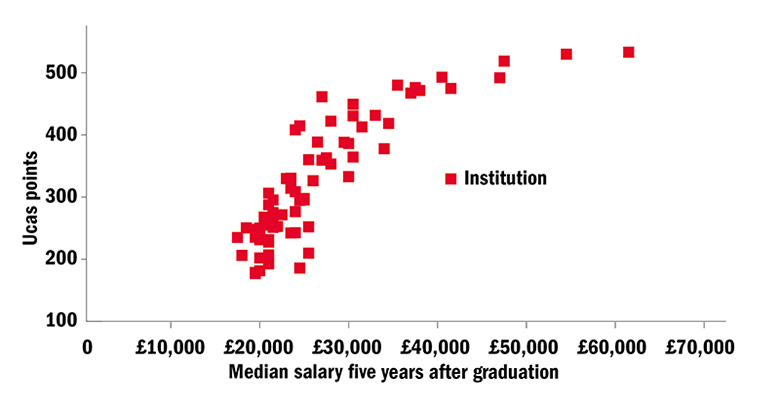Government figures on graduate earnings by English university closely reflect the grades that students enter with, analysis by Times Higher Education shows, but outlying universities show that the data could transform student choice, some believe.
The Department for Education recently published the latest batch of figures from its Longitudinal Education Outcomes (LEO) project, which links individual education and tax records.
In a major development, the latest publication included figures on earnings for law graduates at 76 English universities. The DfE plans to develop earnings figures by institution for all courses and to include the data as a metric in the teaching excellence framework.
While some sector figures call the LEO law figures “explosive” and say that the range revealed between institutions could show students that where they study matters hugely for lifetime earnings, others argue that earnings heavily reflect the prior attainment of each university’s students and where in the country they work after graduation.
Whether, and how, the LEO data are benchmarked when included in the TEF is a key question for the government.
THE analysed the LEO data on law graduates’ median earnings five years after graduation (for the 2008-09 graduating cohort) against data on average entry tariffs for students on those courses, provided by the Higher Education Statistics Agency.
The earliest data that Hesa could provide were for students who started their courses in 2007-08 – but the figures provide a rough match for the LEO data on the assumption that universities did not radically change their entry tariffs.
The results of the analysis (see graph) show a reasonably strong correlation (0.85) between graduate earnings and entry tariffs.
But there are also cases of note beyond this trend that could be at least partly explained by differing regional destinations of graduates, experts suggest. The University of Exeter, for example, shows median earnings in law of £34,500. Despite having a marginally higher entry tariff than Exeter, the University of Sheffield’s earnings figure is £28,000.
London Economics, a consultancy firm, conducted its own analysis, sharing the results with THE. By looking at the range in entry tariffs against the range in earnings, the consultancy calculated that entry tariff “is responsible for approximately half (48 per cent) the variation in annual earnings”.
Who's in the money? Law earnings by average entry tariff

Source: Higher Education Statistics Agency/Longitudinal Education Outcomes. Analysis by THE.
Notes: Average law entry tariffs taken from cohort who entered university in 2007-08. Salary data come from those who graduated in 2008-09.
Gavan Conlon and Maike Halterbeck of London Economics, who conducted the analysis, also found that an institution being located in London “is associated with a wage premium (of £5,941 per annum)”.
They also took the University of Kent as a useful mid-point institution in the law figures.
Once they had controlled for factors including entry tariffs and location in London or the regions, they found that “only six institutions (the University of Oxford, University College London, the University of Cambridge, Canterbury Christ Church University, the University of Warwick and Oxford Brookes University) had earnings returns at the median that were statistically significantly above the University of Kent”.
Dr Conlon and Ms Halterbeck added that “only four institutions (Lancaster University, the University of Leeds, the University of Liverpool, and Brunel University London) had earnings returns at the median that were statistically significantly below the University of Kent”.
Lord Willetts, who advocated the gathering of data on graduate earnings by institution in his time as universities and science minister, welcomed the LEO figures but added: “This information is not simply telling you about a university – it’s telling you about the background of the students.”
There could be “very significant value added even if people do not end up with the highest earnings”, he continued.
Another sector expert said that it was “the differences within tariff point bands which are likely to prove most useful for prospective students in making choices”, and that “once this information is properly exposed to prospective students, those institutions with the weaker earnings will likely have to drop their entry tariffs”.
Anna Vignoles, professor of education at Cambridge, who worked on another major project on graduate earnings published earlier this year, said that it was “definitely important that students consider average earnings of graduates alongside entry tariffs”.
While Professor Vignoles said that “benchmarking similar institutions (in terms of entry tariff) in the same region or across similar regions is an obvious option”, she cautioned that the “region issue is tricky”.
She continued: “Most Exeter students come from elsewhere and presumably can go on elsewhere to work. Other institutions, such as Leeds, do more to recruit students locally (which should be encouraged) but then such students are often less mobile.”
Professor Vignoles suggested that the “proportion of local students” could be another key factor to consider.
后记
Print headline: Entry grades heavily influence earnings, analysis suggests




